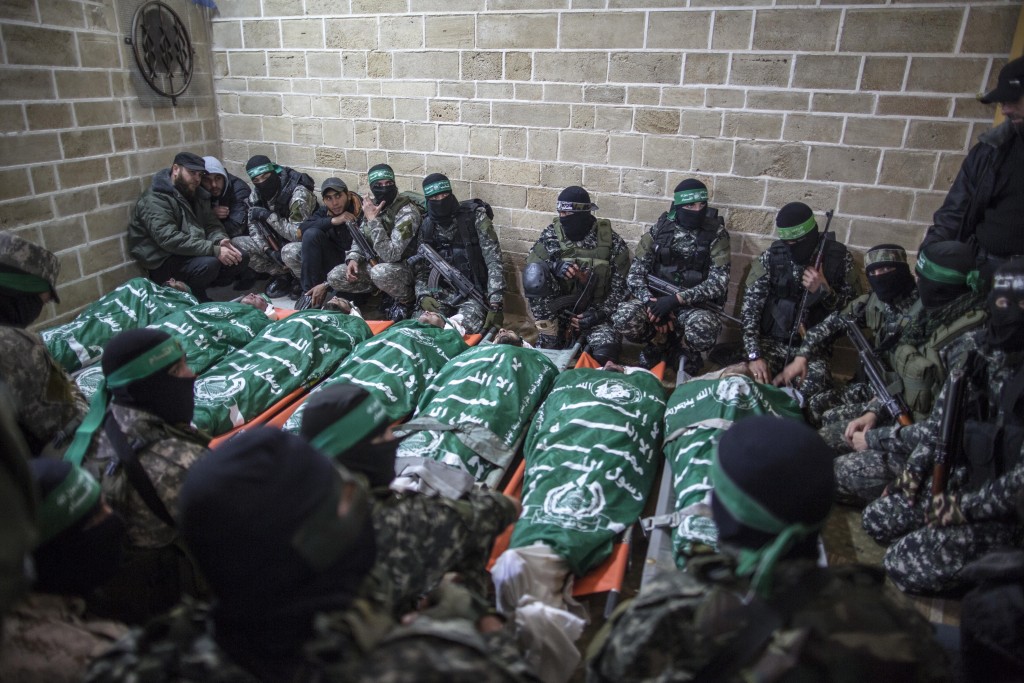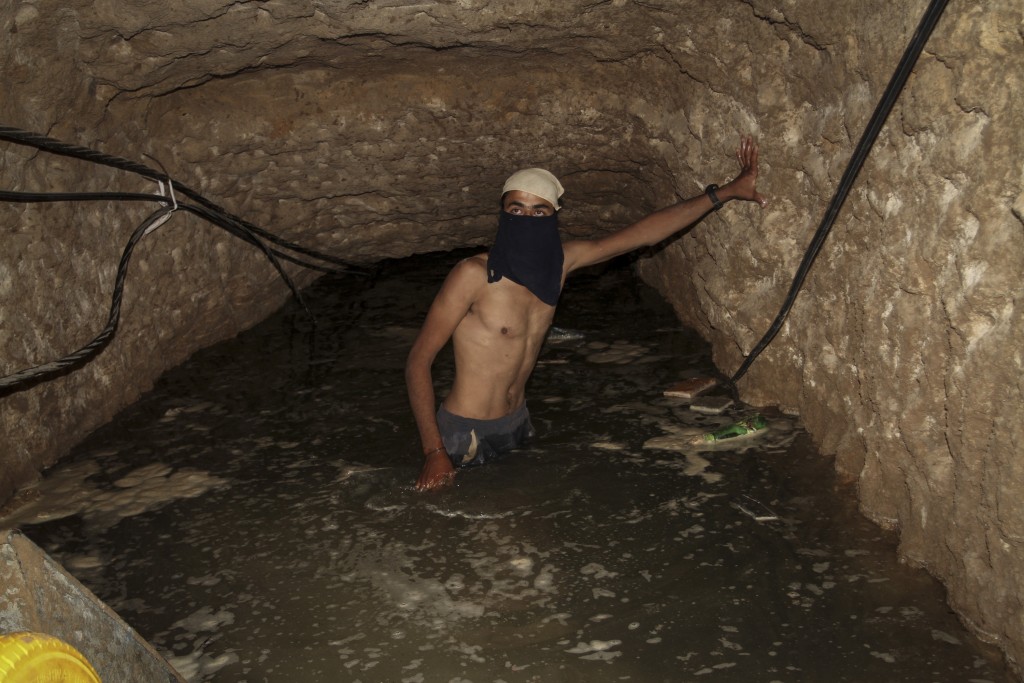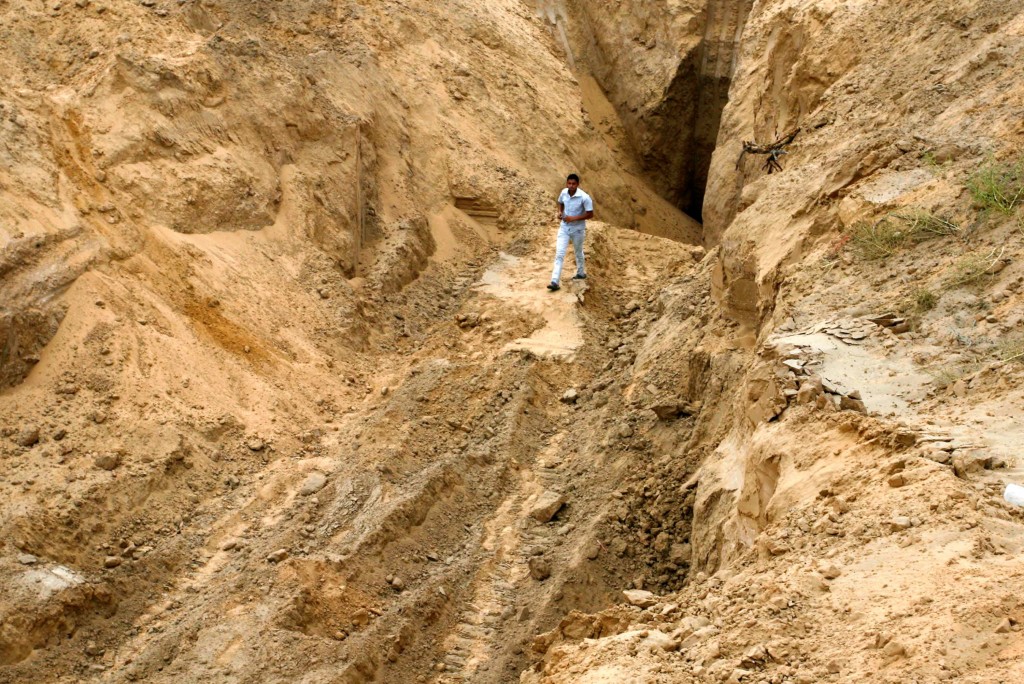Hamas says its smuggling and terror tunnel network is twice as large as the Viet Cong’s was at the height of the Vietnam War. Here’s what Israel is doing to stop it.
Is another Gaza war inevitable? Judging by the latest reports in the Israeli media, it might seem that way. At a funeral for seven Hamas militants killed in a tunnel collapse, Hamas’ Gaza-based chief Ismail Haniyeh declared that the so-called “terror tunnels” are a mainstay of the terrorist group’s strategy against Israel. A senior Israeli defense official told reporters that Hamas has mostly rebuilt its tunnel infrastructure, which Israel destroyed in Operation Protective Edge in 2014. During the operation, the IDF demolished 32 tunnels, 14 of which crossed into Israel for the purpose of conducting terror attacks. Hamas publically confirmed their ongoing efforts to rebuild the tunnels by praising its subterranean heroes who are “toiling day and night” on reconstruction. Meanwhile, reports have trickled out of Gaza that six tunnels collapsed over the past two months, killing at least thirteen Gazans.
The debate further heated up when a sneak peek at a State Comptroller report showed great dissatisfaction with how the Israeli Defense Ministry was handling the tunnel threat. Residents in communities near the Gaza border complain that they can hear and feel digging under their homes. In response, Prime Minister Benjamin Netanyahu promised he would respond appropriately to all threats and “will act very forcefully against Hamas, and with much more force than…Protective Edge.” Opposition leader Isaac Herzog, not to be outdone, called on Netanyahu to “bomb the tunnels and destroy this threat.…Why are we waiting? For terrorists with…weapons drawn to emerge in a kibbutz?” Jewish Home leader Naftali Bennett similarly called for a preemptive attack on the tunnels. In any case, the public remains on edge.
But is war inevitable? And is it the best option?
Gazans have been using tunnels regularly since the mid-1990s, when they were dug under the Gaza-Egypt border in Rafah for smuggling purposes. By 2001, and again in 2004-2005, Hamas terrorists used tunnels to plant explosives under IDF installations. In 2006, Hamas dug a tunnel into Israel near Kibbutz Kerem Shalom, ambushed a tank unit, kidnapped Corporal Gilad Shalit—who would be held in captivity for five years—and killed two of his fellow soldiers.
By 2009’s Operation Cast Lead, Hamas’ use of tunnels had evolved into a clear threat. In 2012’s Operation Pillar of Defense, the IDF targeted the tunnels as much as it did Hamas’ rocket capabilities. In 2013, a large tunnel was discovered that led to an Israeli town. It was clearly intended for a large-scale terrorist attack. An even bigger tunnel was discovered later that year.
During Protective Edge, a major tunnel infiltration aimed at the residents of a kibbutz near the Gaza border was thwarted just as terrorists were emerging on the Israeli side. Four more such attacks would be interdicted, some with the Hamas fighters having already crossed into Israel. One attack was successful; five Israeli soldiers were killed. Hamas even used a tunnel to try to kidnap a soldier after a ceasefire had come into effect. The tunnel extended for over a mile, some of it deep into Israeli territory. What had originally been an operation to halt Hamas’ rocket fire evolved into an operation to neutralize the tunnel threat.
Between Israel’s 2005 withdrawal from Gaza and June of 2007, when Hamas violently overthrew the Palestinian Authority and took control of the Strip, Israel had a border-crossing agreement with the PA to regulate the flow of people and goods into Gaza. The EU assisted in a similar arrangement between Gaza and Egypt. Even after the short-lived agreement was signed, however, Hamas and Islamic Jihad continued to launch rockets and mortar rounds from Gaza, including attacks on the border crossings, using arms smuggled in via the tunnel system. Since Israel imposed a naval blockade on Gaza in 2007, meant to prevent Iranian arms from arriving in much greater quantities, the tunnel system became a lifeline for Hamas. Between 2005 and the eve of Protective Edge, Hamas and Islamic Jihad terrorists launched more than 11,000 rockets at Israeli civilians. Protective Edge saw another 4,700 rockets fired. All had been smuggled in whole or in part through Hamas’ tunnels.
Clearly, then, the tunnel infrastructure is both Hamas’ primary military asset and a major threat to Israel’s security. How can Israel effectively combat it?
The history of warfare is, in essence, a history of constant adaptation to an enemy’s capabilities. The tunnels were born out of this competition. They are classic examples of asymmetric warfare, in which a much weaker enemy takes advantage of the vulnerabilities of a militarily stronger force. But it is important to differentiate between the three distinct types of tunnels used by Hamas, and explore their tactical and strategic importance.
The original tunnels, as noted, were and still are used to smuggle arms and commercial goods from Egypt to Gaza. Hamas substantially expanded this infrastructure after 2007 and Israel’s imposition of a blockade. At the time, it is estimated that there were as many as 2,500 such tunnels running between Gaza and Egypt in the area of Rafah. Their entrances were placed inside civilian buildings for the purpose of concealment. Most of these tunnels are deep underground—often dozens of feet—with reinforced concrete walls, electricity, and a communication infrastructure. Some are wide enough to accommodate vehicles. There are estimates that as much as $3 billion in goods were moved annually from Sinai into Gaza, avoiding the established import mechanism run by Israel, Egypt, and the Palestinian Authority. Hamas collects hefty taxes on most of these goods. However, following the fall of Egypt’s Muslim Brotherhood president Muhammad Morsi and Hamas’ support for ISIS-linked terrorists in Sinai, Cairo cracked down. It constructed barriers, built a buffer zone, and flooded hundreds of tunnels. The Egyptian military claims to have destroyed over 1,500 such tunnels since current President Abdul Fattah al-Sisi came to power.
A second type of tunnel is the tactical or “defensive” variety. These are meant to assist Hamas in its next war if Israel sends in ground troops. They form a subterranean web underneath Gaza, and give fighters and commanders freedom of movement, allowing them to evade capture, hide from aerial assault, and maintain the element of surprise. Rockets, launchers, and ammunition are also stored in these tunnels, so Hamas can continue firing even while under aerial attack. Hamas commanders are said to have personal tunnels for themselves and their families. It is assumed that Hezbollah, whose underground capabilities were exposed during the Second Lebanon War in 2006, influenced this strategy. The U.S. military experienced this threat firsthand in Vietnam.

Members of the Izz ad-Din al-Qassam Brigades, Hamas’ militia, pray near the bodies of seven members who were killed while repairing a tunnel, January 29, 2016. Photo: Emad Nassar / Flash90
It is the third type of tunnel, however, which is most worrying—the terror tunnels. Given Israel’s security fence and buffer zone on the border, Hamas was left with essentially two options for launching attacks on Israel—going over the fence, via rockets and mortars, or going under it. And since Israel’s anti-missile capabilities have advanced to the point where the rocket threat is largely neutralized, Hamas shifted its investments underground.
During Protective Edge, IDF combat engineers destroyed 32 such tunnels—some reaching hundreds of meters into Israel. The IDF has since announced that Hamas has resurrected its tunnel capability in the two and a half years since Protective Edge. Hamas itself corroborated this. These tunnels allow Hamas terrorists to carry out two types of operations that worry Israel the most—attacks on civilian populations and the kidnapping of IDF soldiers, who would be taken back to Gaza through the tunnels in order to serve as bargaining chips.
IDF intelligence and military planners have been aware of this emerging threat for some time now, with Chief of Staff Gadi Eizenkot affirming that it is now one of the army’s main priorities. Despite this and nearly a billion shekels (about $250 million) spent over the past decade in search of a solution, there are still only a limited number of ways to detect and fight the tunnels—which is primarily why Hamas is so keen on using them.
As far as detection, technologies are still limited, although the Israeli Ministry of Defense has been working around the clock on the problem for some time. Successful early testing was conducted this past year, but an operational solution—essentially an Iron Dome for tunnels—is still a ways off. Last April, the U.S. House of Representatives unanimously approved a bipartisan amendment to the National Defense Authorization Act known as the “Tunnels Amendment,” co-sponsored by Reps. Doug Lamborn (R-Colo.) and Gwen Graham (D-Fla.). The amendment will grant significant funding, alongside Israeli investments, to speed up research and development on tunnel detection by injecting tens of millions of dollars into the project, much as the U.S. supported Israel’s development of Iron Dome. The bill was signed by President Obama in November of 2015, including the Tunnels Amendment (section 1279). According to U.S. Defense Department spokesman Christopher Sherwood, the U.S. appropriated $40 million for the 2016 financial year, with possible additional appropriations in 2017 and 2018.

A Palestinian man stands in a smuggling tunnel in Rafah, southern Gaza, October 1, 2015. The tunnel, which leads to Egypt, was flooded with seawater by the Egyptian army. Photo: Abed Rahim Khatib / Flash90
Tunnel-detection technology is being developed by Israeli defense contractor Elbit Systems, and will eventually use advanced sensors to give the precise location of underground excavation work. Once identified, engineering troops can drill holes directly into the tunnels at various locations and drop in explosives. The problem at the moment is that the system has difficulty detecting turns or making sense of intersections, and cannot detect smaller tunnels or tunnel openings. Engineering troops active during Protective Edge in 2014 noted that the tunnels are not necessarily straight lines with an opening at both ends. They often discovered three or four entrances and multiple connections with other tunnels. And whether it comes from Congress or the Knesset, Israel will still need to invest a few hundred million dollars more in order to bring the new system online.
This means that technology will complement but not replace ground troops and intelligence efforts for the foreseeable future. During Protective Edge, Israel sent limited amounts of troops to detect and destroy tunnels. But at the moment, sending in troops capable of such a mission will certainly lead to an escalation that Israel does not want. Hamas is similarly deterred, and is careful not to complete its work, stopping short of its destinations so as to avoid detection until an operation is launched.
That leaves intelligence as the key. Satellites and drones have limited capabilities against tunnels, and Hamas is very careful in regard to its communications. This leaves human intelligence capabilities and other covert efforts in Gaza to detect tunnel entrances. Hamas, it should be noted, is also careful in this regard, and reportedly executed dozens of tunnel diggers in the past to prevent them from leaking information to Israel.
But even if detected, destroying the tunnels is not easy. Israeli airstrikes over the years have had limited success, as Hamas engineers simply went further underground and reinforced the tunnels with concrete. Pumping seawater into the tunnels, as Egypt does, is not an option for Israel, which does not have access to the tunnels without setting off another war. Using explosives is ineffective for the same reason.
The recent tunnel collapses are most likely a result of rainy weather, which floods the already sandy ground in which the tunnels are constructed. This problem is only compounded by Gaza’s faulty sewage and drainage infrastructure. However, reports coming out of Gaza that sensors and cameras were discovered in some tunnels, the very visible engineering vehicles and equipment seen working near the Gaza border, plus ambiguous comments by Israeli military figures regarding the collapses, all may hint that Israel may have found some success in sabotaging the tunnels.
There is a tragic side to Hamas’ tunnel strategy. Roughly 9,000 homes were destroyed during Protective Edge, and very few have been rebuilt. This is not Israel’s fault, as building supplies flow regularly into Gaza. But according to declassified intelligence reports, these supplies are routinely stolen by Hamas in order to serve the group’s terrorist purposes. Hamas smuggles in cement, diverts from construction and humanitarian donations, and even raids civilian construction sites in order to rebuild its tunnels. Estimates are that one tunnel can cost a million dollars to build and uses around 50,000 tons of concrete. Close to a million tons of concrete were poured into the terror tunnels before 2014.
The tunnels, in this sense, are a zero-sum game. If the same materials were put into reconstruction, the Gazan people would be better off and, lacking this crucial asymmetric warfare capability, Hamas would be less tempted to attack Israel. On the other hand, with the same limited materials going to terror tunnels, the people of Gaza continue to live in ruins while Hamas rebuilds its war machine.
While Hamas appears to be deterred in the short term, it continues to believe that the tunnels are its only strategic weapon. While it may not be interested in another war, the tunnels continue to be dug for a reason. Once used, however, they lose their effectiveness, as the IDF knows their locations and can thus destroy them. Hamas is well aware of this dilemma. The tunnels essentially leave Israel and Hamas in an arms race—with Israel racing to develop a technological solution before Hamas decides to launch another round of fighting.
Militarily, Israel is left with a tough choice—strike now and almost certainly spark another war, or wait till Hamas strikes and risk a civilian massacre in one of the Israeli communities near the Gaza border. Small wonder that Israel’s political leaders are on edge.
But Israel does have a number of options, and they tend to go together.
First, Israel must continue and increase its intelligence efforts. This means aggressively gathering intelligence on tunnels that cross into Israel and taking limited action, as much as is possible, to neutralize them. If the hints at sabotage are correct, then this seems to be a preferable course, in that it has yet to elicit a face-saving response from a deterred Hamas. In any case, a clear picture of tunnel locations will be crucial should Hamas launch another war.
Second, U.S.-Israel cooperation on anti-tunnel technology is crucial and will eventually provide a solution. This clearly benefits Israel, but will also aid the U.S. It ensures that Israel can defend itself against threats, thus staving off the next round of fighting. And by researching, developing, and field testing new technologies in Israel, the US can then deploy these same technologies on its southern border, and help defend foreign bases and embassies from infiltration abroad.
Third, if military, intelligence, and technological solutions are limited, crafty diplomacy seems to be a quiet but promising measure. There are already reports that Israel and Hamas have been communicating through Turkey and Qatar in order to reassure each other that neither is interested in further escalation at this point.
And, this is where U.S. and European leaders can play an especially constructive role. In a highly unstable region in which moderate states like Egypt, Jordan, Saudi Arabia, and the Gulf kingdoms are fighting against extremists, the political situation does not favor Hamas. Even Turkey, Hamas’ nearest political supporter, may be mending its ties with Israel. This was already evident in 2014, as few countries in the region rushed to condemn Israel as Hamas rejected 11 ceasefires that Israel accepted.

A Palestinian man looks at what used to be a tunnel leading from the Gaza Strip into Israel, August 5, 2014. Photo: Abed Rahim Khatib / Flash90
The U.S. could be key to coordinating an effort to bring Egypt, Jordan, Saudi Arabia, the Gulf kingdoms, and Turkey to create a mechanism for regional oversight of the import of construction supplies into Gaza alongside tight supervision of reconstruction. Eventually, this could even lead to a NATO-supervised port in Gaza and a relaxation of Israel’s blockade. If this can be done in tandem with what is left of the Palestinian Authority, all the better.
In return, Hamas must agree to expose and destroy the terror tunnels reaching into Israel. Obviously, this is easier said than done. But in return, Hamas would gain much needed legitimacy, increased international aid, actual reconstruction, and a placated public who should not be living in squalor and ruin—even if it is of their own making. The regional moderates making up such mechanism would gain much-needed stability in an unstable region as they deal with a rising tide of Islamic extremism, the Syrian civil war, and a resurgent Iran. The U.S., going into a presidential election, would gain much needed quiet for a key ally while also contributing to regional stability.
The next Gaza war is not inevitable. By combining intelligence, military and technological efforts, and a discreet and concerted diplomatic push to restrain Hamas and speed up reconstruction, a fourth round of fighting can be pushed off significantly. It’s certainly worth a try.
![]()
Banner Photo: Wissam Nassar / Flash90





